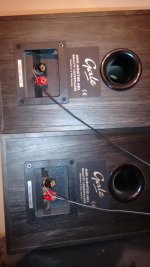Hey all,
I have a hifi with standard speakers that connect to the main hifi unti by connecting some exposed copper wire then screwing the red and black connectors down.
I have an audio interface (Focusrite Scarlett) with RCA output.
I have attached a picture of my speakers, they are Gale Mini Monitor MK2 Speakers. I'm not sure though if the connections on the speakers can be used as RCA as well?
Can I use these speakers as PC Monitors?
Really would appreciae the help, thanks
I have a hifi with standard speakers that connect to the main hifi unti by connecting some exposed copper wire then screwing the red and black connectors down.
I have an audio interface (Focusrite Scarlett) with RCA output.
I have attached a picture of my speakers, they are Gale Mini Monitor MK2 Speakers. I'm not sure though if the connections on the speakers can be used as RCA as well?
Can I use these speakers as PC Monitors?

Really would appreciae the help, thanks

